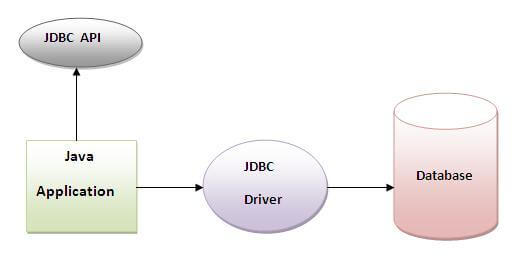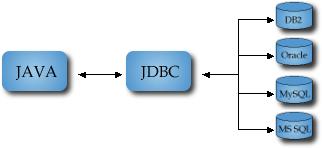JDBC connectivity model,


JDBC stands for Java Database Connectivity, which is a standard Java API for database-independent connectivity between the Java programming language and a wide range of databases.
The JDBC library includes APIs for each of the tasks mentioned below that are commonly associated with database usage.
- Making a connection to a database.
- Creating SQL or MySQL statements.
- Executing SQL or MySQL queries in the database.
- Viewing & Modifying the resulting records.
The JDBC API provides the following interfaces and classes
- DriverManager: This class manages a list of database drivers. Matches connection requests from the java application with the proper database driver using communication sub protocol. The first driver that recognizes a certain subprotocol under JDBC will be used to establish a database Connection.
- Driver: This interface handles the communications with the database server. You will interact directly with Driver objects very rarely. Instead, you use DriverManager objects, which manages objects of this type. It also abstracts the details associated with working with Driver objects.
- Connection: This interface with all methods for contacting a database. The connection object represents communication context, i.e., all communication with database is through connection object only.
- Statement: You use objects created from this interface to submit the SQL statements to the database. Some derived interfaces accept parameters in addition to executing stored procedures.
- ResultSet: These objects hold data retrieved from a database after you execute an SQL query using Statement objects. It acts as an iterator to allow you to move through its data.
- SQLException: This class handles any errors that occur in a database application.
JDBC packages
The java.sql and javax.sql are the primary packages for JDBC 4.0. This is the latest JDBC version at the time of writing this tutorial. It offers the main classes for interacting with your data sources.
The new features in these packages include changes in the following areas −
- Automatic database driver loading.
- Exception handling improvements.
- Enhanced BLOB/CLOB functionality.
- Connection and statement interface enhancements.
- National character set support.
- SQL ROWID access.
- SQL 2003 XML data type support.
- Annotations
ReplyDeleteThanks for sharing this amazing blog
Java Online Training Hyderabad
good blog
ReplyDeleteWell researched article and I appreciate this. The blog is subscribed and will see new topics soon.
ReplyDeleteJava training in Chennai
Java training in Bangalore
After reading this web site I am very satisfied simply because this site is providing comprehensive knowledge for you to audience.
ReplyDeleteThank you to the perform as well as discuss anything incredibly important in my opinion. We loose time waiting for your next article writing in addition to I beg one to get back to pay a visit to our website in
Selenium training in bangalore
Selenium training in Chennai
Selenium training in Bangalore
Selenium training in Pune
Selenium Online training After reading this web site I am very satisfied simply because this site is providing comprehensive knowledge for you to audience.
Thank you to the perform as well as discuss anything incredibly important in my opinion. We loose time waiting for your next article writing in addition to I beg one to get back to pay a visit to our website in
Selenium training in bangalore
Selenium training in Chennai
Selenium training in Bangalore
Selenium training in Pune
Selenium Online training
Thank you for taking the time and sharing this information with us. It was indeed very helpful and insightful while being straight forward and to the point.
ReplyDeleteoracle training in chennai
oracle training in velachery
oracle dba training in chennai
oracle dba training in velachery
ccna training in chennai
ccna training in velachery
seo training in chennai
seo training in velachery